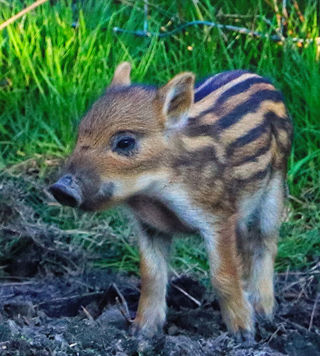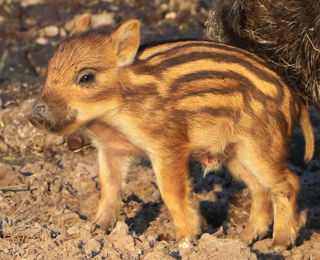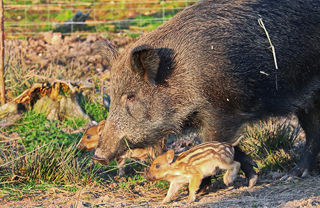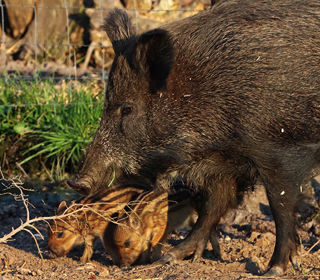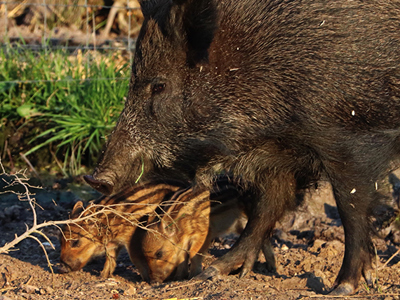
Wildwood welcomes first babies of the year
2nd Apr 2019
Ash, Wildwood’s young female wild boar, produced a litter of two boarlets last week and has just brought them out of their nest. Proud father, Sherwood, is keeping an eye on the boarlets who can be seen keenly exploring their new surroundings. This is the first birth at Wildwood this year with others expected to follow any day, such as red squirrels, reindeer and Soay sheep.
Wildwood Trust is campaigning to save wild boar from being hunted to extinction and has asked the Government to legalise the status of this animal to let it take its rightful place in the British Countryside. Wild boar form an integral part of the historic landscape of Britain and help woodland flowers, insects, animals and trees regenerate, creating a diverse countryside full of wildlife and plants. We have been lobbying hard to ensure wild boar are given a chance to regain their natural place in our countryside to help our children enjoy the landscape created by this incredible woodland manager. If you make a visit to Wildwood over the next few days, you should be able to see the piglets taking their first steps. Our sow, Ash, prepared to give birth by constructing a nest of branches into which the babies were born. The first boarlets born chose a teat near their mother’s head so that they had a better chance of attracting her attention.
Did you know?
- Boarlets are born with stripes and these help to camouflage them in the undergrowth.
- The litter stays in the nest for about 10 days.
- The young are suckled for about 12 weeks before they are completely weaned onto food, which they find while rooting around with their mother.
Wild boar facts
The European Wild Boar (Sus scrofa), ancestor of the domesticated pig, is the largest of the present-day wild hogs – the males or boars sometimes reaching a height of 40 inches at the shoulder and a weight of 350 pounds. A male wild boar is armed with a pair of large sharp strong tusks, the upper canine teeth, which curve outward and upward, reaching a length of ten inches in old age.
- The wild boar has a gregarious nature and is mainly woodland dwelling.
- Wild boar mainly feed on deer truffles, acorns, nuts, tubers, insects, earthworms and some carrion.
- Vocalisations are very important, and wild boar are constantly grunting and chirruping to each other, and squeal when alarmed.
- Wild boar are usually not dangerous and do not attack other animals and people. However, they can be very aggressive, especially females with young, or injured animals.
- Wild boar are naturally timid and (normally!) run away at the sight of people.
- Wild boar have a life span of between 15 and 20 years.
A history of wild boar in Britain
The date at which wild boar finally became extinct in Britain is unclear due to subsequent attempts at re-introduction. In continental Europe, wild boar were (and still are) widely distributed and attempts were made in the 18th and 19th centuries to re-introduce animals to Britain from abroad, initially into private estates for hunting purposes. James 1st released animals firstly from France and then from Germany into Windsor Park in 1608 and 1611 respectively. His son, Charles 1st (reigned 1625-1649), also released boar into the New Forest from Germany. It is thought that the original British wild boar were probably extinct by the 13th century, and the re-introduced animals became extinct during the 17th century. Between the 17th century and the 1980’s, when wild boar farming began, only a handful of captive wild boar, imported from the continent as zoo exhibits, were present in Britain. Until very recently, no free-living wild boar (native or introduced) have been present in Britain for the last 300 years.

